
Here are some hands I’ve played that I believe are particularly instructive. I don’t win every pot, I don’t make the correct decision at every opportunity, but I did learn something in each hand. The hands that I misplay or miscalculate are the most instructive.
![]()
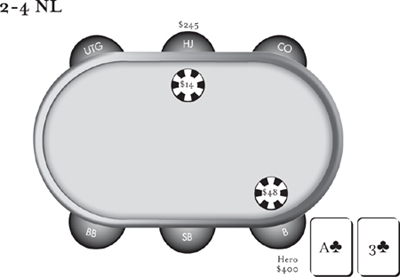
My opponent is playing 50/26/0 and opens to $14 from the Hi-Jack. I three-bet to $48, mostly to isolate the fish and play a pot in position. Of course, he calls. I’m fairly confident this player will just call my three-bet with many of his strong combinations, and also check-fold most flops that he misses.
Pot: $102 Flop:Q♠T♥5♣
Opponent checks. This is a very standard flop for a continuation-bet, so I fire $56—no reason to go crazy with a pot-size bet—against fit-or-fold types, a smaller continuation-bet in three-bet pots is correct.
He calls. After the call, I’m certain that he’ll call a turn bet as well—no more bluffing for me.
Pot: $204 Turn: 2♦
I pick up a gut-shot straight draw and a little equity, but not enough to get me to try another bluff. He checks, and I check behind hoping to hit an Ace or a 4 on the river. I take my “free” card.
River: 4♦
Opponent shoves all-in for $191, and of course I snap-call. He had TT and flopped middle set.
By betting flop and checking the turn, I gave myself a chance to realize the inherent equity of my hand. And yes, I got lucky too.
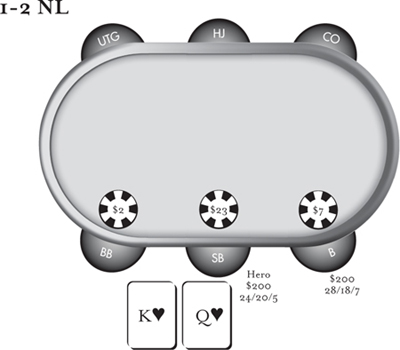
My opponent is playing 28/18/7 and opens from the button for $7. I three-bet to $23 for value with the K♥Q♥ and he calls. I think my opponent will have a wide range—he’s the type that loves to play a pot in position (who doesn’t?) and isn’t afraid to mix it up a bit. He has a lot of small pocket pairs and Broadway (AJ, AQ, KQ, KJ) combinations in his range.
Pot: $48 Flop: T♥5♥3♣
I flop a very good hand: a flush draw and two over cards. This flop also misses my opponent’s Broadway combinations. A continuation-bet is mandatory: $20 seems about right—I will make the same size continuation-bet with air as well on a flop like this. My opponent calls, and I
suspect that there are quite a few “floats” in his range now, and very few strong combinations—I wouldn’t expect him to slow-play a set in this spot. I plan on barreling most turn cards.
Pot: $84 Turn: A♠
The Ace looks scary, but it is actually one of the best cards in the deck if my range analysis is correct. My opponent has a few Aces in his range that floated the flop, but they are not as common as the times that he called with either air or a medium pair. I expect that my opponent will give up all the medium pair hands if I double-barrel. And, even if I get called, I’ve set up stacks nicely for a shove on the river if I hit my straight or flush.
Since there really aren’t any extremely strong combinations in my opponent’s range, I think a half-pot turn bet is all I need. I fire $42. My opponent sighs, shows 88, and mucks.
Use range analysis on the turn to figure out if betting will show a profit.
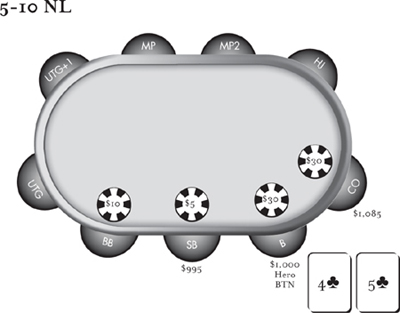
An unknown opponent raises to $30 from the cutoff. I call with 4♣5♣ on the button and the small blind comes along as well.
Pot: $100 Flop: T♣7♠4♦
The cutoff makes a continuation-bet of $80 and I decide to float. With bottom pair and a backdoor-flush draw, my hand is very well disguised and when I improve I expect to get paid when my opponent actually has something. When I don’t hit, there will be a lot of good opportunities to bluff on the turn and make my flop call profitable. The small blind folds.
Pot: $260 Turn: 4♠
I improve to trips on the turn and my opponent continuation-bets again—this time for $140. This is a terrible card for my opponent to be continuing with as a bluff, but he’s probably not a great player. His bet sizing is small relative to his bet on the flop, so I think he has either a weak made hand or a bluff most of the time. I elect to call because I get more value from this range by letting him value-bet thinly on the river and continue with his bluffs.
Pot: $540 River: 3♣
My opponent bets $290, I shove and my opponent folds. My read was right and I got more value by waiting for the river to raise.
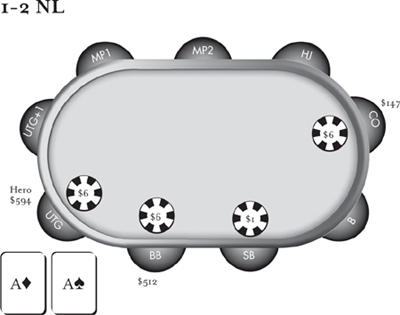
I raise under the gun to $6 with A♦A♠ and get called by the cutoff and the big blind. My opponent in the big blind is a solid regular in the $1/2 games on Full Tilt and the cutoff is an unknown.
Pot: $19 Flop: A♥3♦4♦
The big blind bets $10 and with stacks this deep, I would never be raising when he donks. I call and the cutoff calls. Slow play.
Pot: $49 Turn: K♠
The big blind bets $34 on the turn and after both the cutoff and I called, he continues betting with what looks like it could be a flush draw. I have blockers to him having an Ace, so he’s pretty likely to have a set. I overbet the pot, making it $166 so that I can bet slightly less than the pot on the river. The cutoff folds and the big blind calls.
River: 8♣
My opponent checks and I put him in for his remaining $332 and he calls with a set, 3♥3♠. There wasn’t much he could do and I don’t think he could really get away from his hand, but the bet sizing and line of play made getting all the money in a certainty.
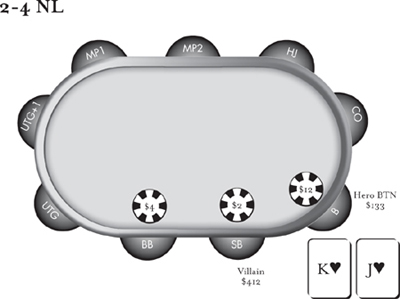
I raise K♥J♥ to $12 from the button and an opponent makes it $40 from the SB—I have a substantial number of hands with this player and my HUD tells me he three-bets 12% from the small blind. My opponent is re-raising with a wide range and I have position post-flop. KJ suited plays well enough to justify calling, so I do.
Pot: $84 Flop: K♣5♦2♠
My opponent continuation-bets $48. I think he’ll make a continuation-bet on this board with his entire range. The flop hits his range harder than it hits my perceived range, but I have a blocker to him having a King. My opponent is very aggressive and I expect he thinks I will just call with my middle pocket pairs and top-pair—type hands to allow him to continue barreling.
This time, I get a little tricky and throw in a min-raise. I have every intention of calling a shove. Against a loose-aggressive opponent, this can be just the type of bet to help them spew. He knows that I would almost always four-bet AK pre-flop. My pre-flop calling range is fairly wide. He perceives my min-raise as a very narrow range of hands that include many bluffs.
He shoves, I call instantly, and he meekishly shows 6♣4♣ (gut-shot, backdoor flush draw.) I win the pot when the board bricks off and slow down his three-betting in the process.
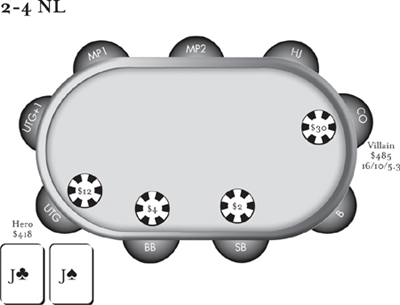
I raise to $12 with JJ under the gun, the cutoff re-raises to $30 and action folds around to me. Over a small sample of 49 hands, my opponent has played 16/10/5.3 pre-flop and has a low aggression factor of 1.0, so I expect him to be fairly straightforward post-flop. I call.
Pot: $63 Flop: J♣8♥7♦
I decide to donk bet $42. I need to start building a pot because my opponent is not very aggressive post-flop. The low aggression factor leads me to believe that he’ll rarely bet this flop with air. If I’m going to get maximum value, I can’t rely on him to bet for me. I’m hoping to bet two-thirds of the pot on the turn and three-fourths the pot on the river.
Pot: $147 Turn: 8♥
The turn gives me a lock on the hand and my bet sizing is the only relevant factor. I planned this on the flop and follow through with a bet of $98. Thankfully, my opponent calls again.
Pot: $343 River: 2♥
I shove for $260 and my opponent folds. I’m pretty sure my opponent folded an over-pair on the river, so I take a note: “Three-bet, called two donk bets, and folded to a third barrel on J8782 rainbow board.” I’ll be able to use this note to exploit his tendency to make nitty folds in three-bet pots by triple-barreling air on dry flops in the future.
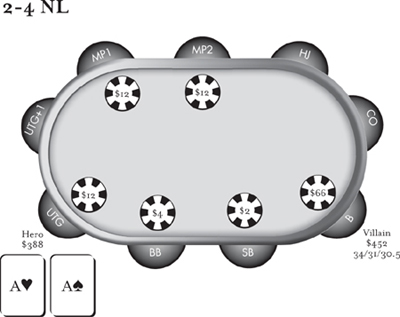
I raise to $12 with A♥A♠ UTG, two players call behind me, and an opponent playing 34/31/30.5 over 59 hands three-bets to $66 from the button. Even though my sample is small, I can be very confident that my opponent is trying to take advantage of being “anonymous.” Unfortunately for him, I have a HUD and pocket Aces.
His range is very weak. I don’t want to give him a reason to stop bluffing, so I call and the other two players fold. I’m hoping he’ll put me on 99-JJ, AK, AQs+.
Pot: $162 Flop: T♣9♦5♥
I check and my opponent bets $160. If I shove, my opponent will be getting 3.7 to 1 pot odds and I don’t expect him to fold if he has any piece of the flop or an over-pair. I move all-in for $334 and my opponent flashes AK and folds.
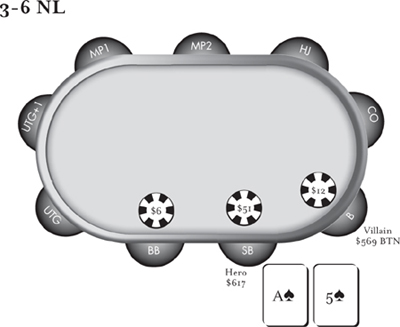
I’m in the small blind with A♠5♠ and my opponent, a smart LAG, opens to $12 on the button. I’ve played thousands of hands with this opponent and know that he opens 67% of hands on the button and four-bets 15% when he gets three-bet. He is a big winning player and I know that he knows that I three-bet from the small blind 10% of the time. I elect to re-raise to $51, and with the A♠5♠, I plan on bluff-shoving if he four-bets me small. This time, he just calls.
Pot: $106 Flop: T♣2♠8♦
I flop a backdoor-flush draw and the board is T high. There will be a lot of good cards I can barrel on if I continuation-bet—any spade, J, Q, K, or A. Since it’s a three-bet pot, I don’t need to bet much more than half the pot to threaten stacks. I bet $63 and my opponent calls. He will float often after he adds up the evidence: dry flop, wide three-bet range, dry flop, automatic continuation-bet.
Pot: $232 Turn: 8♠
I pick up a flush draw as the board pairs on the turn. My opponent knows that I know that this is a bad card for me to barrel as a bluff. He will not expect me to be bluffing very often when I bet. Since I actually improved, I barrel, making it $153 to go. My opponent calls and given how I’ve set up stack sizes, I can be pretty sure that he has a made hand that is not going to fold on the river.
Pot: $538 River: J♠
I river the flush and shove for $401. My opponent calls and mucks his KK when I show him the bad news.
Notice that he did not four-bet my raise out of the small-blind! That’s wonderful news for my ability to five-bet-jam A5s profitably against this opponent in the future. He is capable of just calling the top of his range when facing a three-bet, and since he is four-betting so frequently, there are going to be many combinations of hands that will be four-betting and folding pre-flop to a five-bet shove.
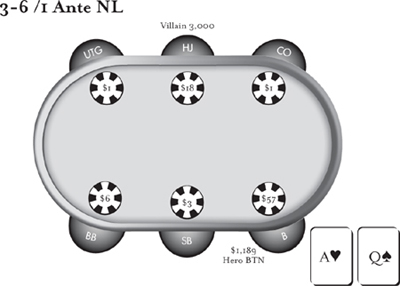
A LAGtard who opens a wide range of hands, calls three-bets too frequently, and plays too aggressively post-flop opens to $18. I pick up A♥Q♠ on the button and three-bet to $57. He calls.
Pot: $129 Flop: Q♦2♦2♥
I flop the world. After my opponent checks, my only consideration is how to get as much value as possible. I have almost 10x pot left behind, and I would often make a very large continuation-bet to leverage the power of my entire stack. But, after checking my HUD, I see that over my 300-hand sample, my opponent has check-raised 20% of his hands post-flop. I may not have enough data points, but I decide to bait him with a small bet of $75. He immediately comes over the top making it $244. Cha-ching. I want to keep the fish on the line, so I call.
Pot: $617 Turn: 8♥
My opponent checks a brick turn and I bet $285—a bit less than half the pot sets me up to make a similar size bet on the river. My opponent min-raises to $570 and I shove for a total of $947. With the flush draws on the board, I can never fold a hand as strong as AQ against this opponent. He calls with A♥T♥.
Of course, the river brings a heart and my opponent makes a flush. Sad. I won the battle but lost the war. Remember to give those LAGtards enough room to bluff—bet small and let them think they have fold equity.
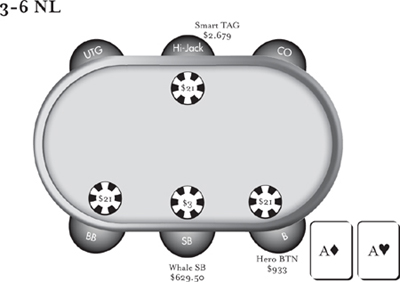
A smart tight-aggressive player opens to $21 from the Hi-Jack at a six-handed table. I would normally re-raise with A♦A♥ on the button, but an epic whale is in the small blind, so I invite him to enter the pot by calling. The whale obliges and comes along.
Pot: $69 Flop: K♣8♦2♣
The whale donks and bets. The smart tight-aggressive player re-raises to $144. KQ, KJ, Ace-high flush draws, and sets are all in the TAG’s range. I just call to keep the whale in the pot. He calls. I’m hoping to trap the TAG in the pot if the whale donks the turn.
Pot: $501 Turn: 3♦
With $466 left behind, the whale shoves and the smart TAG calls. Normally, with this action I would say that my TAG opponent’s range is KK, 88, 22, AA, AK. Even though I am behind this range—there are six combinations of AK that I beat and nine combinations of KK, 88, 22 that beat me—the whale rarely has me beat and I can never fold getting 2.2 to I on my remaining stack.* I shove for $789. The smart TAG calls and shows A♠K♦. The river bricks with a 7♦ and the whale mucks 9♠4♥!
When you have a monstrous whale at the table, remember to play your hands in a way that gives him as many chances as possible to screw up.
A smart loose-aggressive opponent with whom I have a lot of history raises to $25 on the button. I’m in the big blind with 7♠8♠. My opponent’s aggression makes playing a hand like this difficult out of position when he has the lead, but he folds a little too frequently to my three-bets, so I re-raise to $90 and he calls.
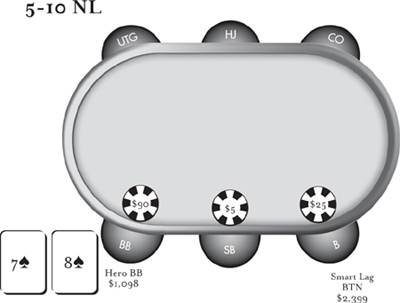
Pot: $185 Flop: Q♥5♦2♠
I make a small continuation-bet of $100 and my opponent calls. Since my opponent is a strong player, I probably should have given up on the flop. My HUD tells me that my opponent does not fold to continuation-bets in three-bet pots very often (50%) and this is a perfect flop for him to float because he knows that the flop improves his calling range more than my three-betting range.
Pot: $385 Turn: 6♠
The turn improves my equity dramatically, giving me a monster straight and flush draw. Time to barrel. By betting, I get to set my own price for my straight draw. He is unlikely to raise with any of his value hands because he has position and needs to balance the times that he is calling with a weak QX or 77-JJ. I also expect to fold out many of his hands that have me beat—mainly, his floats and his medium pairs. I bet $220, setting stacks up for a slightly less than pot-size river shove. My opponent calls.
Pot: $825 River: A♠
The river gives me the flush and I shove for $778. My opponent calls with A♦J♦ and mucks.
My read was spot-on throughout, and again, I got a little lucky on the river. But I was able to extract maximum value with my hand because I set up the stack sizes properly with my flop and turn bets.
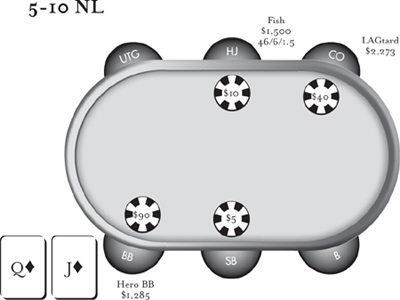
A loose-passive fish playing a 46/6/1.5 style limps the Hi-Jack, and a bad loose-aggressive player that has raised 40% of 86 times in the cutoff raises to $40.
I’m in the big blind with Q♦J♦ and I decide to three-bet for value and to isolate. The LAGtard in the cutoff only folds to three-bets 11% of the time and QJ suited plays very well against a 36% range—even out of position.
Another good reason to three-bet is that the LAGtard is playing deep and I can’t buy-in for an amount that covers him. In these situations, I like to play a higher variance style to give myself more opportunities to increase my stack size and have the fish covered on future hands.
I make a tiny three-bet of $90. My goal is to keep the pot as small as possible while still getting the limper to fold. That way, I maximize my maneuverability and keep my option to triple-barrel open.
The limper folds and the LAGtard calls.
Pot: $195 Flop: 5♦4♥5♣
The flop is very dry and I expect this player will call a continuation-bet just about every time. A low paired board like this one will set up lots of profitable turn and river bluffing spots, so I make a continuation-bet of $150 and my opponent calls. I want to set up about a 3/4-pot bet on the turn and 3/4-pot shove on the river.
Pot: $495 Turn: K♥
The turn is a perfect card to barrel. I might get a light call on the turn if he is suspicious, but he’ll fold by the river unless he has some stupid 5X or KX hand. I bet $350 and my opponent calls.
Pot: $1,095 River: 6♥
The river brings in a backdoor-flush draw, but it’s not important. Neither of us has many flushes in our range. I gulp, reexamine the hand from all angles, and follow through with a triple-barrel shove for $700. My bluff only has to work 39% of the time to break even, and I expect my opponent to have enough weak hands in his range for my bet to be profitable. However, this time, he turned up with K-5 for a full house.
Even though I lost the hand, I believe my line is profitable over the long run against this player. I hope my wife wasn’t watching.
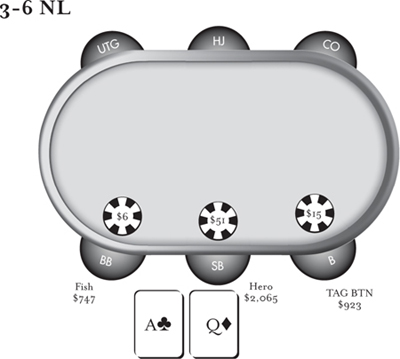
My opponent raises to $15 on the button. The only fish at the table is in the big blind, so even though my HUD tells me that my opponent raises 50% of the time on the button, I think his range is closer to 70% or 80% this time—he’ll be picking on that fishy player in the big blind with just about every hand.
I wake up with A♣Q♦ and three-bet to $51. The fish folds and my opponent calls.
Pot: $108 Flop: J♦7♦7♠
The flop is dry and I make a continuation-bet of $70. I have been pretty quiet this session and I think this player is capable of folding a hand as strong as KJ to a triple barrel if he doesn’t improve. I make a medium-size bet, which will allow me to set up stacks for a pot-size shove on the river. I estimate my opponent’s calling range to consist of floats, flush draws, middle pairs, some suited connectors that hit trip sevens, and Jacks as weak as J9s.
Pot: $248 Turn: 2♣
The turn changes nothing and I continue with my plan. I make a bet of $190, which sets up a pot-size bet on the river when I’m called. My opponent calls.
Pot: $628 River: 3♣
I shove for $627 and my opponent folds and shows QJ.
It takes serious balls to triple-barrel into a guy when you feel strongly they have top pair. I only make this play against good players that are actually capable of laying down top-pair–type hands.
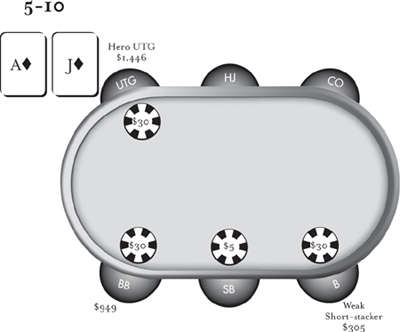
I raise to $30 under the gun with A♦J♦. I get called by a weak short-stacker on the button and a loose-passive player in the big blind.
Pot: $95 Flop: 2♥T♥5♦
Against two bad players and a short-stacker who has position on me, a continuation-bet is mandatory on this flop. Frequently, the button will fold and I’ll gain position on the fish for the rest of the hand.
The big blind checks and I bet $70. The button folds and the big blind calls. I have a note on the big blind that says he plays very loose with draws and weak pairs. He raises his medium-strength made hands. After the call, I assume he is calling with all sorts of flush draws, gut-shot straight draws, weak pairs, and even over-card hands like QJ.
Pot: $235 Turn: 6♠
My opponent checks and I bet $220. I bet big to set up what I think will be a very profitable triple-barrel shove. I expect him to call with a wide range of weak made hands that will fold when I bet big on the river. I also expect him to raise now if he has a hand that will call a river shove.
He just calls, and I believe the stage is set. Cock the gun.
Pot: $635 River: 4♣
My opponent checks again and I follow through with my plan—I go all-in for $657 and my opponent quickly calls with Q♥3♥ and I lose to a rivered straight. Oops!
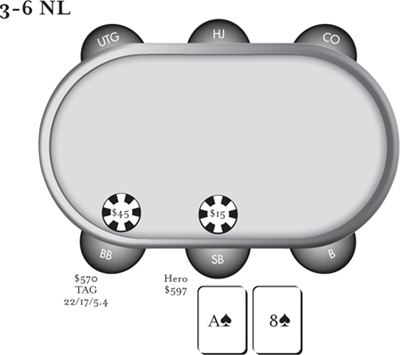
Action folds around to me and I raise to $15 from the small blind with A♠8♠. My opponent is playing a 22/17/5 style and aggressively defends his big blind versus late position raises. He three-bets to $45 and I make a loose call.
Pot: $90 Flop: 9♦6♠5♣
I look at my HUD and see that my opponent makes a continuation-bet 70% of the time in three-bet pots. With a gut-shot, Ace high and a backdoor flush draw, I have good equity against my opponent’s three-betting range so I’m not giving up easily.
I donk into my opponent with a bet of $72 hoping to either win the pot right away or get a read. Read this: my opponent raises to $153.
I should just fold, but I know that he knows that these small raises are very effective against an aggressive opponent and I think he is polarized between air and a very narrow range of sets and AA and KK. I make a pretty bad, spewy call.
Pot: $396 Turn: 4♦
The turn is a meaningless 4♦ and we both check. I’m very surprised that he checked behind. I believe he must be playing a hand like AK, AQ, or a very small pair (22–44).
Pot: $396 River: 6♣
This is a decent card to bluff. I do not want to check and then lose to AQ. I convince myself that my opponent will fold well over 50% of his range and I shove for $414. My opponent trapped me to perfection and shows 5♦5♥. Well played, sir. The check on the turn told a convincing story and really got me.

I raise under the gun to $37 with K♣Q♠. The SB and BB come along. The SB is extremely loose and overly aggressive playing a 50/26/8 style.
Pot: $120 Flop: 5♥Q♦8♣
The small blind makes a small donk bet of $40 and the big blind folds. My opponent in the small blind has been very loose with his calls and very aggressive with a weak range of made hands. He is very unlikely to have a strong hand with this bet and the best play is to raise for value while setting up a pot-size river bet. I make it $120 and my opponent calls.
Pot: $360 Turn: 6♦
This 6♦ doesn’t change much and my opponent donks again with a $120 bet. I think that his range is something like QJ, QT, 67, 78, 89, A8, 57, 54. I am very confident that I have the best hand.
I raise to $320, setting up a slightly less than pot-size shove on the river. Perfect. If he calls, I’m also getting value from his weak paired hands. He calls.
Pot: $1,080 River: J♣
The river definitely could have given my opponent the best hand, but he checks and shoving with thin value is the best play. Since the pot is so big and there is only $591.50 left in his stack, with any kind of very strong hand, I would expect him to shove either on the turn or the river. I’m hoping he has A8o or QT and digs deep to find a call. I shove and my opponent calls with A8 offsuit. Hee haw!
![]()
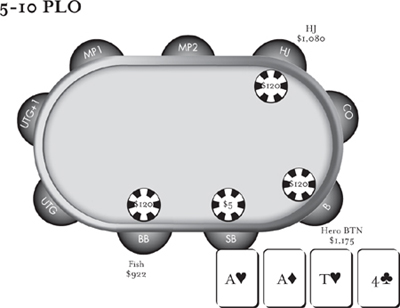
A strong aggressive player raises to $35 from the Hi-Jack and I re-raise to $120 with A♥A♦T♥4♣ on the button. A loose fish calls from the big blind and the Hi-Jack calls.
Pot: $365 Flop: K♣5♦2♥
BB checks, Hi-Jack donk bets $238. My opponent should know that this dry a board is perfect for me to continuation-bet. So, why did he donk? I expect that he’d check-raise KKXX every time. He has to have some sort of weird straight draw or KQT9 type hand. I should raise to protect my hand, but the donk bet confuses me. I decide to call and see the turn. Big blind folds.
Pot: $841 Turn: 2♠
HJ checks. The turn is a good card for my hand because it counterfeits all my opponent’s two pair draws. If he has the KQT9 or similar, he’s drawing to two outs. My only real concern is protecting against straight draws. But, sane opponents won’t have that many straight draws. Maybe I’m leveling myself, but I check behind.
Pot: $841 River: J♣
HJ bets $562. This is a tricky river spot. My opponent is representing a full house. I’m really confused. I just can’t see why he’d donk on the flop. Whatever, at the end of the day, if he checked the flop I’d probably go broke with this hand, so I might as well pay him off now. I call. And of course, he had K♦K♥9♠8♠.
I kept thinking about this hand for three days after, and I am still confused.
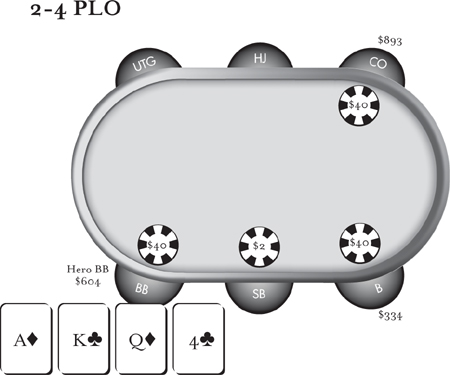
CO raises to $12. BTN calls. Hero raises to $40. CO calls. BTN calls.
A smart, aggressive player raises to $12 from the CO and an unknown player calls on the BTN. I three-bet to $40 from the big blind with A♦K♣Q♦4♣ (definitely a little loose, even double-suited) and both opponents call.
Pot: $122 Flop: 4♥4♦J♥
Nice flop—trips!
I make my standard small continuation-bet—$68. With trip 4’s and only a flush draw to worry about, I bet small to induce a bluff from a naked flush draw. There are not many bad cards for me on the turn and I’m happy to let my opponents see the turn for a cheap price with a wide range. Both of my opponents call. I expect at least one (and probably both!) to have a flush draw.
Pot: $338 Turn: 6♥
The turn brings in the flush, and I know I’m beat. I check and hope that my opponents are too afraid of the paired board to bet their flushes so that I can get a free attempt at making my boat on the river. Unfortunately, after the cutoff checks, the button shoves for $266.
A quick pot-odds calculation ensues:
266 / (338+266+266) = 0.32 = 32% Break Even Point
With at best 10 outs, the rule of 2 says I’ll make a full house 20% of the time:
10 outs 3 2 = 20%
Since I will only win the pot 20% of the time and my break-even point is 32%, I must reluctantly surrender.
A short stack limps from middle position and the small blind completes. I check my option in the big blind with J♠T♠9♥3♣.

Pot: $30 Flop: T♦9♠4♦
SB bets $25, Hero calls $25, MP raises to $50, SB raises to $205, Hero?
The small blind bets $25. On a board as draw-heavy as this one, I expect him to have a lot of draws and strong made hands. We could easily have the same hand, but if I raise, I don’t expect to be getting in my 100 big blinds with the best hand. There are also a lot of bad turn and river cards that make my two pair worthless. So I just call.
The short stack min-raises and the small blind comes back with a raise to $205. With the action back on me, my choice is now clear: fold. At best, I expect to be flipping against one player, and against my opponent’s combined ranges, I’m toast. After the showdown, I see that I made the correct fold. The small blind shows A♦K♦Q♣J♥ and the player in middle position had a set with 9♣9♥J♦7♣. I had less than a 15% chance to win.
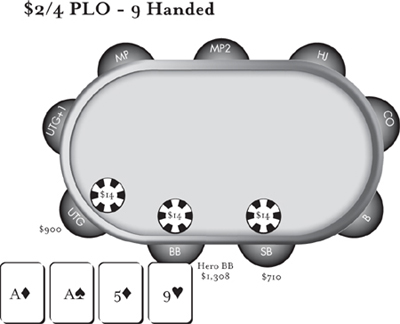
A player opens under the gun to $14 and the SB calls. With weak Aces (A♦A♠5♦9♥), I decide to just call and avoid playing a big pot out of position against a strong under-the-gun opener—he is capable of using his position to make good multi-street bluffs, and I avoid a lot of difficult decisions by just calling. I expect him to be playing many premium rundown hands.
Pot: $42 Flop: 4♣5♦9♠
SB checks, Hero checks, UTG bets $30, SB folds.
The flop is good for my hand, but the board will often develop poorly and make my hand difficult to showdown. I check, and my opponent makes a continuation-bet of $30. After the SB folds, I have an easy call.
Turn ($102): T♠
I check, UTG bets $78.
The turn brings a difficult card. Since my opponent opened from early position, he will usually have two pair with 9TXX or a wrap. If he has a flush draw to go with these hands, I expect him to bet almost all of the time. With AA, I may have the best hand against his wraps. With the naked Ace of Spades, I can also represent the nut flush if a spade hits the river.
River ($258): 7♠
With the nut blocker, I find myself in a great spot to bluff. My turn range analysis leads me to believe that my opponent has some combination of a flush draw with a wrap/pair/two-pair–type hand. Since my range consists mostly of wraps and two-pair hands on the flop and turn, my opponent will likely try to bluff if he can’t beat the 8-high straight. He may also give up occasionally and let me win with AA.
I check and he bets $192. I’m a little surprised by his river-bet size. If my opponent had a flush, I would expect him to bet smaller since he can’t have the nuts and my most likely hand is a non-nut, 8-high straight. I could also have a weak flush, but when he bets this big, he can’t really be expecting me to bluff-catch very often.
My bet-sizing read combined with the nut blocker in my hand makes a river-bluff check-raise a must. I re-raise the pot to $834. After a mournful sigh, he folds.
An opponent raises under the gun to $7, UTG+1 calls, and I make a loose call in the small blind with J♦T♣8♦6♥. The big blind comes along and we have four-way action on the flop.
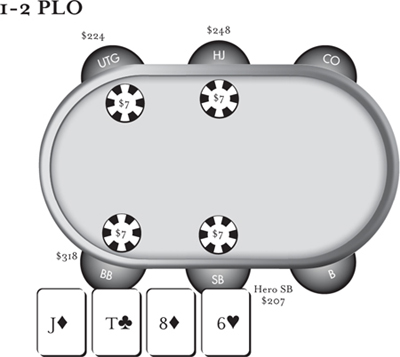
Pot: $28 Flop: 8♣7♣5♦
The flop is fairly locked-down, but it’s not a good spot to check-raise. If the flop was lower and I was heads-up, I could make a move. But trying to make this move on this board in a four-way pot is crazy. In addition, my relative position is terrible because the SB is the most likely player to wake up with 96XX and the UTG and UTG+1 player are most likely to bet and call a check-raise with hands that have good equity against the current nuts.* I make a small bet of $12 with back-door diamonds, a gut-shot straight draw, top pair, and a blocker to the nuts. The big blind folds and both my other opponents call. I expect my opponents to have a range that consists of over-pairs with backdoor-flush draws, two-pair hands, and wraps.
Pot: $64 Turn: 3♦
I expect both of my opponents to have draws against the range I represent if I bet again—(96XX, 88XX, 77XX, 55XX)—and it’s extremely rare for either of them to show up with 96XX or a set themselves. With this in mind, I don’t expect my opponents to be betting or raising this turn card. I’ve improved my equity by picking up a backdoor-flush draw, so I bet $44 to set up stacks for a pot-size river shove. The player in the Hi-Jack calls.
River ($152): 6♦
I hit my flush, but there is not much value in betting. I decide to bluff-catch. I check, my opponent puts me all-in, and I call quickly for my remaining $151. He shows A♣9♣T♥J♦ and I win the pot with a flush.
5-10 PLO
The variance in PLO frequently leads to deep-stacked games. Live, this is even more common as the buy-ins are usually uncapped. This hand was played in a live PLO game at the Wynn.
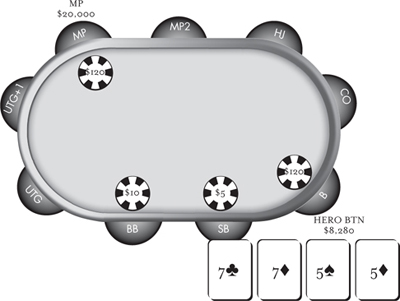
An opponent raises to $35 from middle position. He is a hyper-aggressive player who has been playing fearlessly and using his enormous stack to his advantage, winning lots of hands without showdown. I know that he either loves to run huge bluffs or he is getting really, really lucky by hitting the nuts way more often than expected.
I look down at 7♣7♦5♠5♦ and make a standard three-bet to $120 on the button. We are both very deep and I want to leverage my positional advantage with a hand that flops a set about 25% of the time. Even if I miss, I’ll have a good shot to win the pot after three-betting. Everyone else folds and my mark calls.
Pot: $255 Flop: 5♥4♦J♣
I flop middle set and my opponent checks to me. I make a standard continuation-bet of $185 and get called. I think my opponent often has AAXX, KKXX, QQXX, or a J with backdoor flush and straight potential. A wrap is very unlikely because I have blockers with my sevens.
Pot: $625 Turn: J♥
My opponent checks. I’m not scared of quads or J4, so I value-bet. I’d also bet here with air for balance. I bet $225 and my opponent raises to $575.
The check-raise has me a little concerned, but I still expect to have the best hand much of the time. If I were playing 100bbs deep, this would be a simple “all-in” situation. However, since there is so much left behind and I’ll never make the nuts, I need to be very careful not to put in too much money and value own myself.
I think my opponent’s most likely holding AJ98 type hands. Less often, he will have a complete bluff or a better full house. I call. I have position and there is still over 4x the pot left in my stack after calling.
Pot: $1,775 River: 2♠
My opponent checks again and I think he’s giving up. I think for a minute and decide to bet $725. I think I can get a call from a Jack or a rivered straight by betting small.
My opponent immediately pots, making it $3,950. Uh oh. Really? Pots like this make Omaha a sick game.
There is a ton of money on the line. He’s representing J5XX or JJXX. Neither seem very likely. After I called the turn, there are many full houses in my range, including the hand I actually hold. Does he really think I’d make a thin value bet with AJXX? (I would.)
So I think his check-raise is a response to his perception that I’m value betting thinly with a hand like AJXX. Well, if he has AJXX as well, he might think he can blow me off my hand. I will not be at all surprised if he has some comical full house, but I just can’t get myself to fold. I reluctantly call.
“Nice call, Phil. Chop it up.” He flips over AJT9.
“No, thanks,” I retort, “but I will buy you a drink … cocktails for the table, please!” The dealer pushes the mound of chips to me.